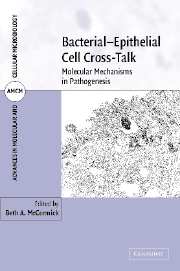Book contents
- Frontmatter
- Contents
- List of contributors
- Part I Introduction to the host and bacterial pathogens
- Part II Bacterial cell biology and pathogenesis
- 3 Bacterial secretion systems
- 4 Microbial molecular patterns and host defense
- 5 Roles of flagella in pathogenic bacteria and bacterial–host interactions
- 6 The role of bacterial adhesion to epithelial cells in pathogenesis
- 7 Bacterial toxins that modify the epithelial cell barrier
- Part III Host cell signaling by bacteria
- Part IV Exploitation of host niches by pathogenic bacteria: mechanisms and consequences
- Index
- Plate section
- References
6 - The role of bacterial adhesion to epithelial cells in pathogenesis
from Part II - Bacterial cell biology and pathogenesis
Published online by Cambridge University Press: 12 August 2009
- Frontmatter
- Contents
- List of contributors
- Part I Introduction to the host and bacterial pathogens
- Part II Bacterial cell biology and pathogenesis
- 3 Bacterial secretion systems
- 4 Microbial molecular patterns and host defense
- 5 Roles of flagella in pathogenic bacteria and bacterial–host interactions
- 6 The role of bacterial adhesion to epithelial cells in pathogenesis
- 7 Bacterial toxins that modify the epithelial cell barrier
- Part III Host cell signaling by bacteria
- Part IV Exploitation of host niches by pathogenic bacteria: mechanisms and consequences
- Index
- Plate section
- References
Summary
INTRODUCTION
Colonizing host epithelia represents a formidable challenge to bacterial pathogens. To a large extent, epithelial surfaces are designed to shield the multicellular organism from the environment and to protect the body interior from potentially harmful microbes. Where epithelial surfaces permit exchange of molecular components with the external world, a multitude of innate and acquired host defence mechanisms keep microorganisms in check. In addition, invading pathogens either have to compete successfully with resident commensal bacteria for space and nutrients or have to reach and establish themselves in otherwise sterile parts of the body. As we will discuss in this chapter, the specific interaction with host surface components and the tight adhesion to epithelial cells form one of the common ways in which bacterial pathogens have evolved to successfully accomplish the colonization of their respective host organism. It is important to emphasize that in many cases, this initial host–microbe encounter at the epithelial barrier is not only a critical determinant of pathogen–host specificity and range but also, to a large extent, a decisive point for the infection process as a whole.
Adhesion of pathogenic bacteria to host cells had been observed at the beginning of the twentieth century in the early days of investigations into the microbiological origin of infectious diseases (Guyot, 1908). However, the concept that bacterial adhesion to host surfaces often represents an essential step in the development of infection matured only several decades later (Beachey, 1981; Duguid, 1959; Eden et al., 1976; McNeish et al. 1975; Punsalang and Sawyer, 1973).
- Type
- Chapter
- Information
- Bacterial-Epithelial Cell Cross-TalkMolecular Mechanisms in Pathogenesis, pp. 158 - 183Publisher: Cambridge University PressPrint publication year: 2006
References
- 2
- Cited by



